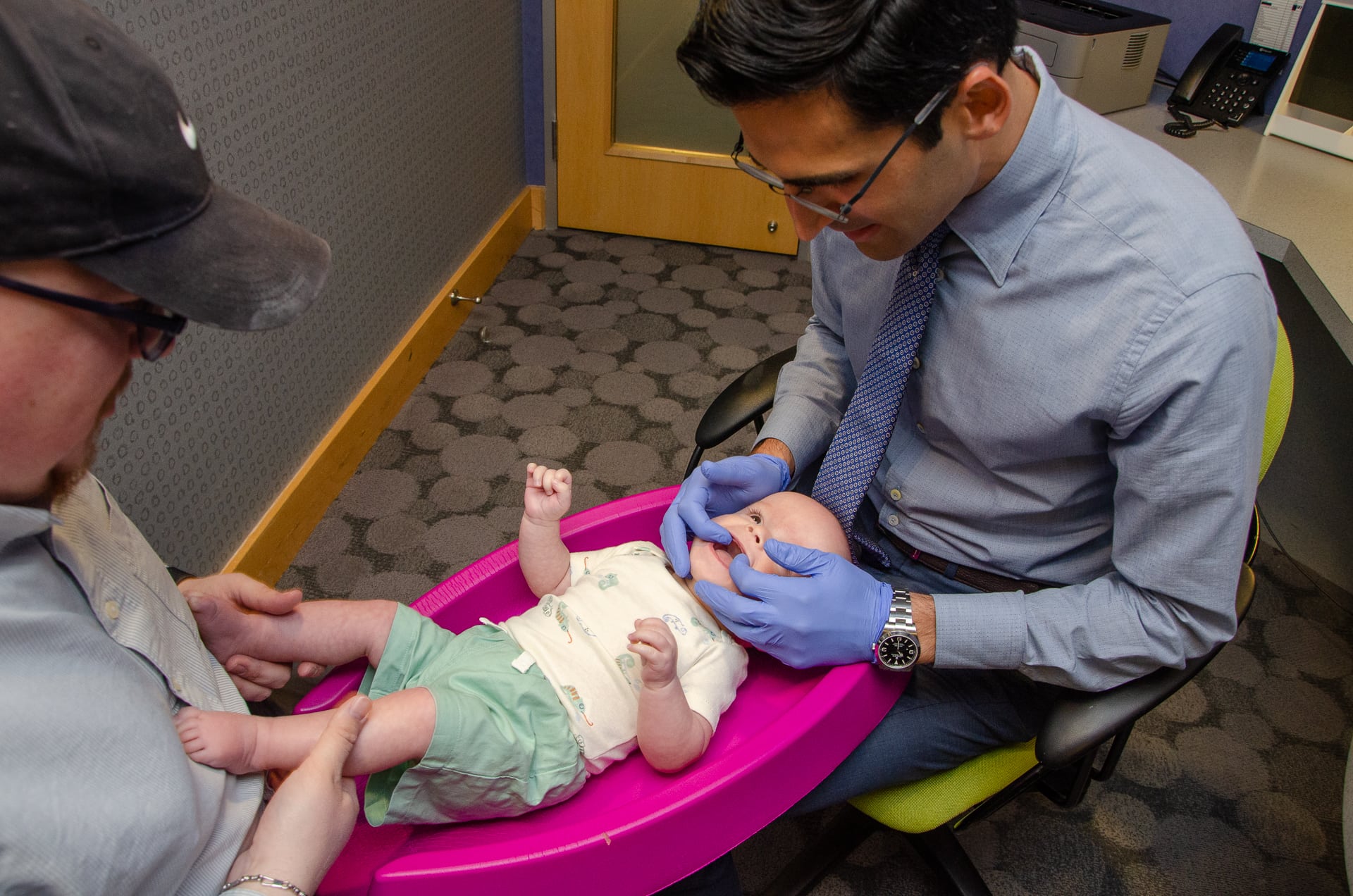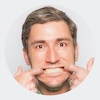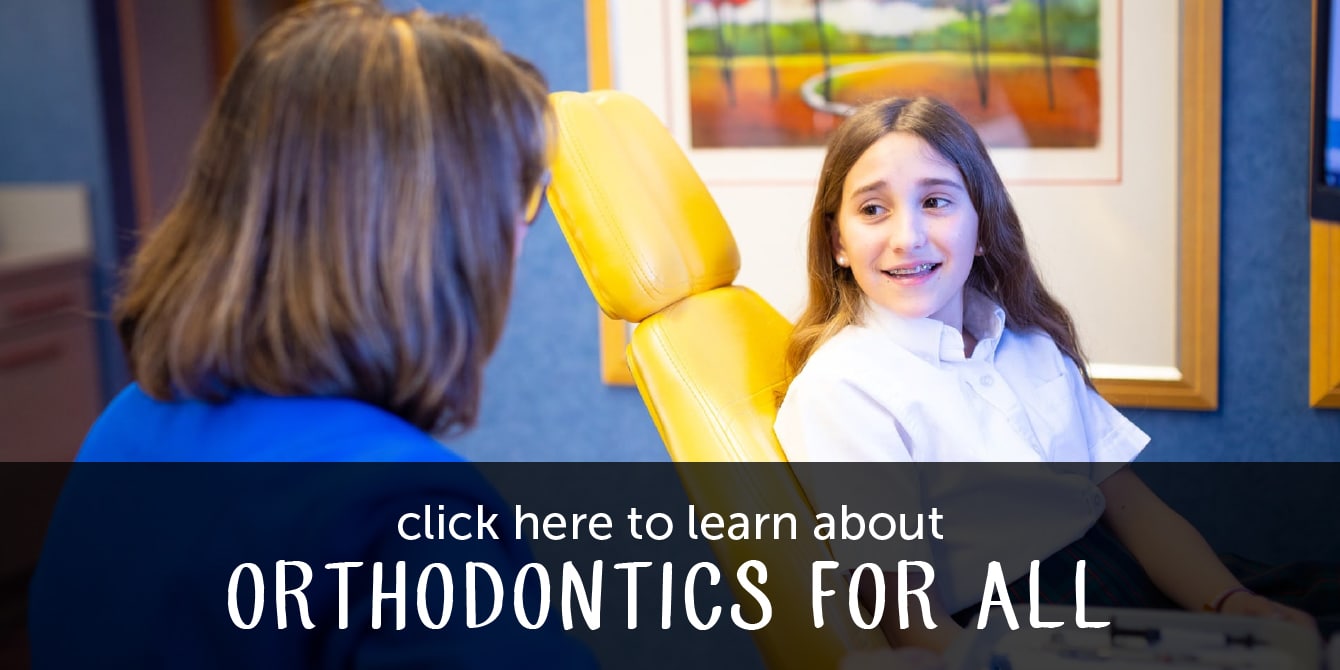Becoming a new parent can feel daunting with many things to learn as you are handed this precious little one to buckle into a car seat and drive home, starting your journey as a family. One question that comes up after a few months of adjusting to feeding, sleeping (we hope) and caring for them is “When do babies start teething?”
Primary and permanent–why so many teeth?
First, why do we even have two sets of teeth? A practical reason might be that our jaws grow so much during the first 12 plus years; baby teeth are sized for the baby jaw, and larger adult teeth fit into an adult jaw. Having baby teeth in an adult would look and function out of proportion. Another benefit is that the baby’s primary teeth are a true gift as a first set to learn how to care for teeth and which foods positively/negatively affect them. Then, we get a second set to apply that knowledge on our forever teeth. Side note: Although not part of the natural 20 teeth dentition, some children are born with extra “natal” teeth (most often on the lower front gums) which can be uncomfortable for the nursing mother or unstable with undeveloped roots. An examination by a dentist will help decide if any action is needed.
When do babies start teething?
About the time your baby begins to explore the world by mouth, putting their hands (and everything else) into their mouth, saliva increases and teething begins. For some, as early as three months is when a tooth can emerge, but the most frequent age is six months old.
The usual suspects of teething are excessive drooling (sometimes causing a rash around their mouth), chewing on objects, crankiness, sore and tender gums, or a slight increase in temperature but not a true fever.
Other symptoms that have been reported coinciding with teething are a runny nose, fever or diarrhea. These symptoms should not be dismissed as “just teething.” They could possibly be signs of other illnesses, and your baby’s doctor should be consulted.
Which teeth come in first?
The lower two, front incisor teeth generally erupt first followed by the upper front two teeth, but there are healthy exceptions where the reverse order is true. Typically, which teeth come in first is also the same sequence they fall out a few years later.
Ideas for managing teething:
- With approval from your child’s doctor, an over-the-counter pain medication, such as acetaminophen or ibuprofen, can be helpful if they are especially uncomfortable and fussy.
- A cold spoon held on their gums or a cold (not frozen) teething ring they can chew may soothe their gums.
- With a clean finger or cool moist cloth, rub their gums using gentle pressure
- Some parents have found teething gels to be helpful, but be careful to avoid all products containing benzocaine or lidocaine which can be harmful due to their numbing effects.
Your child will eventually have 20 baby teeth arriving over the course of two to three years. Yes, they may teethe with a majority of this set. The good news is that there are typically no teething issues when the set of permanent teeth arrives a few years later. Maybe they are just too busy to notice by then! The timing and exact order honestly does not matter, so don’t be concerned if your baby’s experience does not match the chart.
Another note of importance is that some babies don’t get their first tooth until they are one year old or more. We have seen this happen many times, and pediatricians have assured us that their tough gums can chew any food you are allowed to introduce, so no limitations on diet texture. The only downside to getting their first tooth later means that they will also be a bit “later” to lose their first tooth, closer to seven years old. A social right of passage among their friends, it can be frustrating to not be a part of that kinder/first grade Tooth Club. Don’t worry, they will all encounter the Tooth Fairy experience at some point!

How to brush baby teeth
Before they get their first tooth, brushing is not necessary. Simply use a soft wash cloth along their gums twice a day to remove any milk, food or bacteria. When a first tooth appears, it is time to brush. Here’s how to brush baby teeth: use a small, soft-bristled toothbrush to clean both front and back sides of the teeth with massaging circles at the gum line. If the teeth have no space between them, then flossing should begin as well using fun kid flossers.
The safest, most effective position to brush/floss a baby or young child’s teeth is to lay them down length-wise with their head in your lap and resting on the floor. Your legs can become secure boundaries on both sides of their head for less side-to-side wiggle, allowing you to lean forward for an ideal view. Another helpful tip is to wear a headlight, like runners/hikers wear, on your forehead for light to shine into their very dark mouth. This position frees up two hands—using a finger on one hand to lift away the lips and cheeks as you move from tooth to tooth brushing with the other hand. Children often fuss and move as they are resistant to you working in their mouth, so the stability of the floor is helpful for safety.
Another idea is to work with a second adult, both of you sitting in chairs knee to knee facing each other to create a table top. Then, have the child straddle one of your laps and lay back into the other. One of you holds the baby’s hands while the other does the brushing. Having all of your gear ready when you lay your child back makes the effort go much more quickly and effectively. We promise that even if they fuss and cry, they will quickly recover and become more passive as you become consistent and they know what to expect. On your first visit with us, we are happy to demonstrate this positioning as it is how we safely complete our dental exam. We also find that if our patient is accustomed to the reclined position for brushing at home, their dental visits are less stressful as it feels quite familiar.
A third approach when your child is older and needing help, is to have them stand in front of you with their back firmly against your legs, head tilted up for good visuals. Once again, this will allow two hands to be free to retract their cheeks or lips while brushing/flossing, although not quite as stable as the floor. Children generally need help brushing/flossing until fine motor skills are well developed at age eight or nine.
A word about toothpaste:
Until they are one year old, there is no need for toothpaste, as water or a dry toothbrush cleans just as well. If you want to add a flavor then a non-fluoride toothpaste is fine. Beginning at age one, the Academy of Pediatric Dentists recommends using only a rice-grain-sized portion of fluoridated toothpaste (for cavity prevention) in order to limit the amount swallowed. Children are typically unable to spit well until age four, so we suggest an increase from a rice grain to a pea size only when they can rinse and spit thoroughly.
When do babies need to go to the dentist?
The American Academy of Pediatric Dentistry recommends that your baby’s first dentist appointment be within six months of their first tooth. We have a lot of parents asking us why we bother to repair primary teeth since they fall out anyway. Yes, they will lose all 20 of their baby teeth, though not for many years, finishing at about age 12. Those teeth sit above developing permanent teeth buds, so if baby teeth go untreated and become infected, that infection can actually go into the permanent teeth causing damage even before they appear in the mouth.
Let myKIDSdds relieve some of the pressure and guide you through this process. We would love to meet you when your child has their first birthday or even before if you have concerns or questions. Knowing your child and your family’s specific needs will help us support you, as well as be your dental home for any information or emergency care.
















